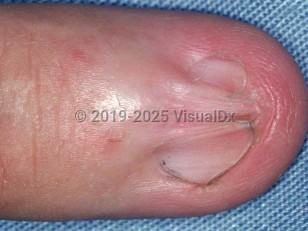Nail pterygium - Nail and Distal Digit
Alerts and Notices
Important News & Links
Synopsis

Pterygium is a nail abnormality that is either dorsal or ventral depending on the site of involvement.
Dorsal pterygium occurs when the proximal nail fold fuses with the underlying matrix and, subsequently, with the nail bed. As a result, the nail plate is divided into 2 lateral segments that progressively decrease in size as the pterygium widens. Complete involvement of the matrix and the nail bed produces a total loss of the plate and a permanent atrophy of the nail apparatus. Dorsal pterygium is most commonly acquired. It arises from conditions involving the proximal nail fold, such as lichen planus, burns, trauma, radiodermatitis, cicatricial pemphigoid, graft-versus-host disease (GVHD), toxic epidermal necrolysis (TEN), pemphigus foliaceus, and Raynaud phenomenon.
Ventral pterygium (pterygium inversum unguis) consists of a distal expansion of the hyponychium, which anchors to the undersurface of the nail plate, ultimately resulting in the obliteration of the distal nail groove. Ventral pterygium is more common in females. It usually arises from conditions involving the hyponychium, such as systemic connective tissue diseases (eg, systemic sclerosis, systemic lupus erythematosus, Raynaud phenomenon), scarring in the vicinity of the distal nail groove, use of formaldehyde-containing hardener, subungual exostosis, stroke, and trauma. Ventral pterygium may also be idiopathic, congenital, or sometimes familial.
Both ventral and dorsal pterygium predominantly involve the fingernails. Aside from the nail dystrophy, patients may complain of pain, particularly in the case of trimming the nails of a ventral pterygium. There may also be functional consequences, such as difficulty in buttoning a shirt or picking up a coin.
Dorsal pterygium occurs when the proximal nail fold fuses with the underlying matrix and, subsequently, with the nail bed. As a result, the nail plate is divided into 2 lateral segments that progressively decrease in size as the pterygium widens. Complete involvement of the matrix and the nail bed produces a total loss of the plate and a permanent atrophy of the nail apparatus. Dorsal pterygium is most commonly acquired. It arises from conditions involving the proximal nail fold, such as lichen planus, burns, trauma, radiodermatitis, cicatricial pemphigoid, graft-versus-host disease (GVHD), toxic epidermal necrolysis (TEN), pemphigus foliaceus, and Raynaud phenomenon.
Ventral pterygium (pterygium inversum unguis) consists of a distal expansion of the hyponychium, which anchors to the undersurface of the nail plate, ultimately resulting in the obliteration of the distal nail groove. Ventral pterygium is more common in females. It usually arises from conditions involving the hyponychium, such as systemic connective tissue diseases (eg, systemic sclerosis, systemic lupus erythematosus, Raynaud phenomenon), scarring in the vicinity of the distal nail groove, use of formaldehyde-containing hardener, subungual exostosis, stroke, and trauma. Ventral pterygium may also be idiopathic, congenital, or sometimes familial.
Both ventral and dorsal pterygium predominantly involve the fingernails. Aside from the nail dystrophy, patients may complain of pain, particularly in the case of trimming the nails of a ventral pterygium. There may also be functional consequences, such as difficulty in buttoning a shirt or picking up a coin.
Codes
ICD10CM:
L60.8 – Other nail disorders
SNOMEDCT:
110987009 – Pterygium of nail
L60.8 – Other nail disorders
SNOMEDCT:
110987009 – Pterygium of nail
Look For
Subscription Required
Diagnostic Pearls
Subscription Required
Differential Diagnosis & Pitfalls

To perform a comparison, select diagnoses from the classic differential
Subscription Required
Best Tests
Subscription Required
Management Pearls
Subscription Required
Therapy
Subscription Required
References
Subscription Required
Last Reviewed:03/31/2019
Last Updated:05/13/2019
Last Updated:05/13/2019
Nail pterygium - Nail and Distal Digit

